Pierre Marquis
CRIL
$Π$-NeSy: A Possibilistic Neuro-Symbolic Approach
Apr 09, 2025Abstract:In this article, we introduce a neuro-symbolic approach that combines a low-level perception task performed by a neural network with a high-level reasoning task performed by a possibilistic rule-based system. The goal is to be able to derive for each input instance the degree of possibility that it belongs to a target (meta-)concept. This (meta-)concept is connected to intermediate concepts by a possibilistic rule-based system. The probability of each intermediate concept for the input instance is inferred using a neural network. The connection between the low-level perception task and the high-level reasoning task lies in the transformation of neural network outputs modeled by probability distributions (through softmax activation) into possibility distributions. The use of intermediate concepts is valuable for the explanation purpose: using the rule-based system, the classification of an input instance as an element of the (meta-)concept can be justified by the fact that intermediate concepts have been recognized. From the technical side, our contribution consists of the design of efficient methods for defining the matrix relation and the equation system associated with a possibilistic rule-based system. The corresponding matrix and equation are key data structures used to perform inferences from a possibilistic rule-based system and to learn the values of the rule parameters in such a system according to a training data sample. Furthermore, leveraging recent results on the handling of inconsistent systems of fuzzy relational equations, an approach for learning rule parameters according to multiple training data samples is presented. Experiments carried out on the MNIST addition problems and the MNIST Sudoku puzzles problems highlight the effectiveness of our approach compared with state-of-the-art neuro-symbolic ones.
Dynamic Blocked Clause Elimination for Projected Model Counting
Aug 12, 2024
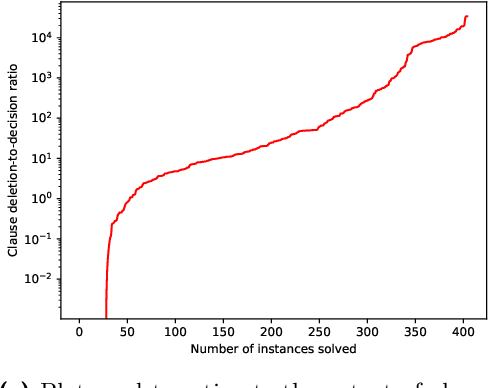
Abstract:In this paper, we explore the application of blocked clause elimination for projected model counting. This is the problem of determining the number of models ||\exists X.{\Sigma}|| of a propositional formula {\Sigma} after eliminating a given set X of variables existentially. Although blocked clause elimination is a well-known technique for SAT solving, its direct application to model counting is challenging as in general it changes the number of models. However, we demonstrate, by focusing on projected variables during the blocked clause search, that blocked clause elimination can be leveraged while preserving the correct model count. To take advantage of blocked clause elimination in an efficient way during model counting, a novel data structure and associated algorithms are introduced. Our proposed approach is implemented in the model counter d4. Our experiments demonstrate the computational benefits of our new method of blocked clause elimination for projected model counting.
Reasoning About Action and Change
Jun 27, 2024Abstract:The purpose of this book is to provide an overview of AI research, ranging from basic work to interfaces and applications, with as much emphasis on results as on current issues. It is aimed at an audience of master students and Ph.D. students, and can be of interest as well for researchers and engineers who want to know more about AI. The book is split into three volumes.
On the Complexity of Enumerating Prime Implicants from Decision-DNNF Circuits
Jan 30, 2023Abstract:We consider the problem EnumIP of enumerating prime implicants of Boolean functions represented by decision decomposable negation normal form (dec-DNNF) circuits. We study EnumIP from dec-DNNF within the framework of enumeration complexity and prove that it is in OutputP, the class of output polynomial enumeration problems, and more precisely in IncP, the class of polynomial incremental time enumeration problems. We then focus on two closely related, but seemingly harder, enumeration problems where further restrictions are put on the prime implicants to be generated. In the first problem, one is only interested in prime implicants representing subset-minimal abductive explanations, a notion much investigated in AI for more than three decades. In the second problem, the target is prime implicants representing sufficient reasons, a recent yet important notion in the emerging field of eXplainable AI, since they aim to explain predictions achieved by machine learning classifiers. We provide evidence showing that enumerating specific prime implicants corresponding to subset-minimal abductive explanations or to sufficient reasons is not in OutputP.
Computing Abductive Explanations for Boosted Trees
Sep 16, 2022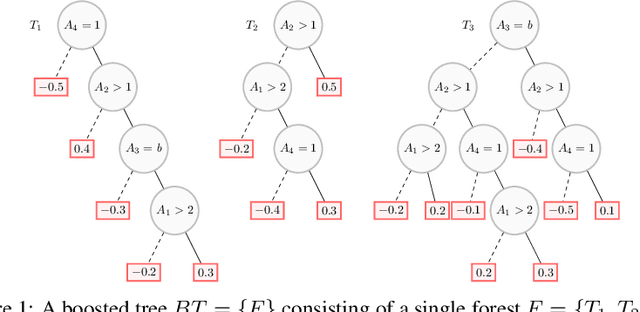

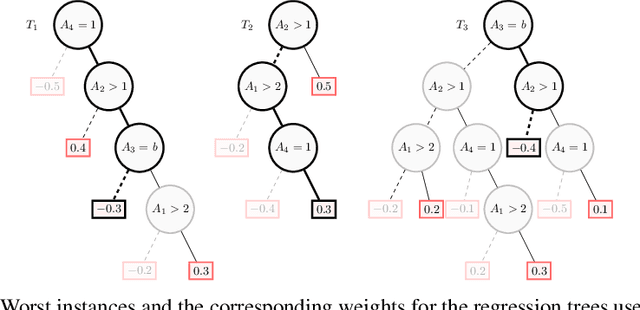

Abstract:Boosted trees is a dominant ML model, exhibiting high accuracy. However, boosted trees are hardly intelligible, and this is a problem whenever they are used in safety-critical applications. Indeed, in such a context, rigorous explanations of the predictions made are expected. Recent work have shown how subset-minimal abductive explanations can be derived for boosted trees, using automated reasoning techniques. However, the generation of such well-founded explanations is intractable in the general case. To improve the scalability of their generation, we introduce the notion of tree-specific explanation for a boosted tree. We show that tree-specific explanations are abductive explanations that can be computed in polynomial time. We also explain how to derive a subset-minimal abductive explanation from a tree-specific explanation. Experiments on various datasets show the computational benefits of leveraging tree-specific explanations for deriving subset-minimal abductive explanations.
Rectifying Mono-Label Boolean Classifiers
Jun 17, 2022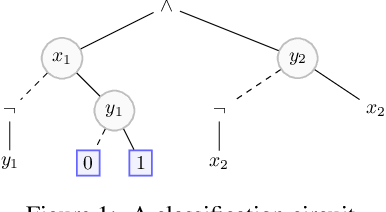
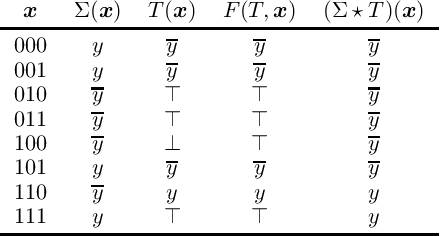
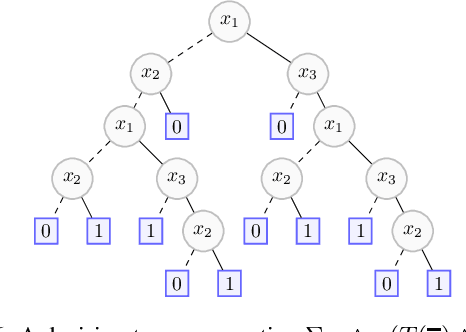
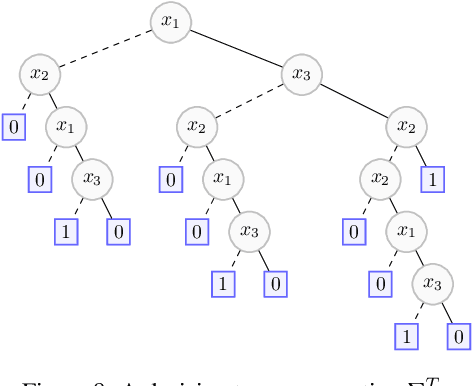
Abstract:We elaborate on the notion of rectification of a Boolean classifier $\Sigma$. Given $\Sigma$ and some background knowledge $T$, postulates characterizing the way $\Sigma$ must be changed into a new classifier $\Sigma \star T$ that complies with $T$ have already been presented. We focus here on the specific case of mono-label Boolean classifiers, i.e., there is a single target concept and any instance is classified either as positive (an element of the concept), or as negative (an element of the complementary concept). In this specific case, our main contribution is twofold: (1) we show that there is a unique rectification operator $\star$ satisfying the postulates, and (2) when $\Sigma$ and $T$ are Boolean circuits, we show how a classification circuit equivalent to $\Sigma \star T$ can be computed in time linear in the size of $\Sigma$ and $T$; when $\Sigma$ and $T$ are decision trees, a decision tree equivalent to $\Sigma \star T$ can be computed in time polynomial in the size of $\Sigma$ and $T$.
Pseudo Polynomial-Time Top-k Algorithms for d-DNNF Circuits
Feb 11, 2022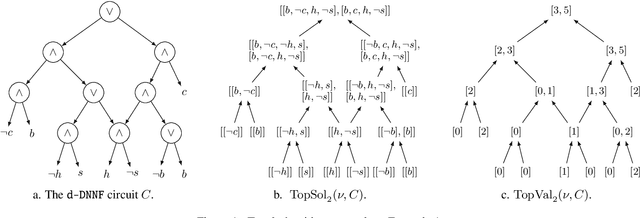

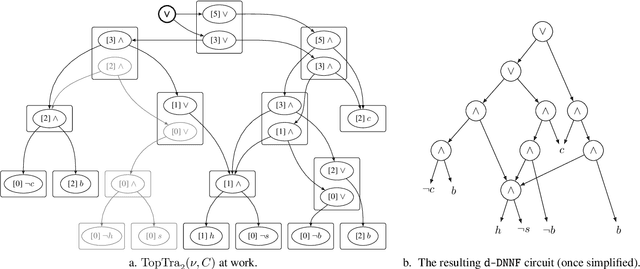
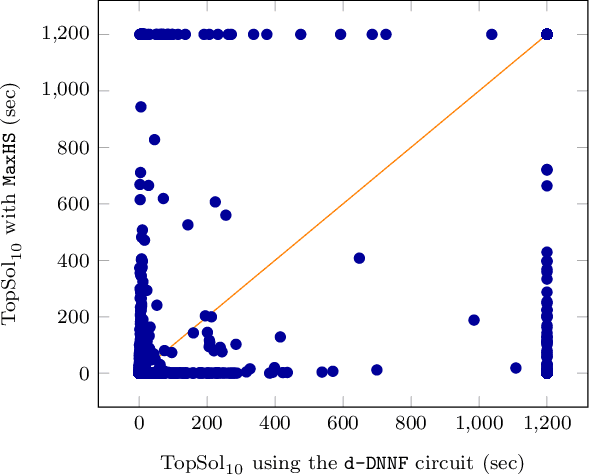
Abstract:We are interested in computing $k$ most preferred models of a given d-DNNF circuit $C$, where the preference relation is based on an algebraic structure called a monotone, totally ordered, semigroup $(K, \otimes, <)$. In our setting, every literal in $C$ has a value in $K$ and the value of an assignment is an element of $K$ obtained by aggregating using $\otimes$ the values of the corresponding literals. We present an algorithm that computes $k$ models of $C$ among those having the largest values w.r.t. $<$, and show that this algorithm runs in time polynomial in $k$ and in the size of $C$. We also present a pseudo polynomial-time algorithm for deriving the top-$k$ values that can be reached, provided that an additional (but not very demanding) requirement on the semigroup is satisfied. Under the same assumption, we present a pseudo polynomial-time algorithm that transforms $C$ into a d-DNNF circuit $C'$ satisfied exactly by the models of $C$ having a value among the top-$k$ ones. Finally, focusing on the semigroup $(\mathbb{N}, +, <)$, we compare on a large number of instances the performances of our compilation-based algorithm for computing $k$ top solutions with those of an algorithm tackling the same problem, but based on a partial weighted MaxSAT solver.
On the Explanatory Power of Decision Trees
Sep 04, 2021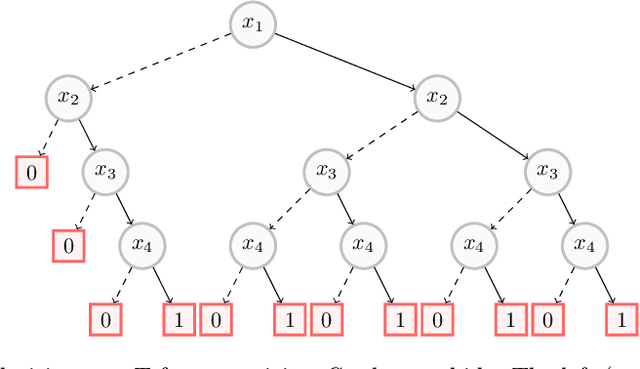
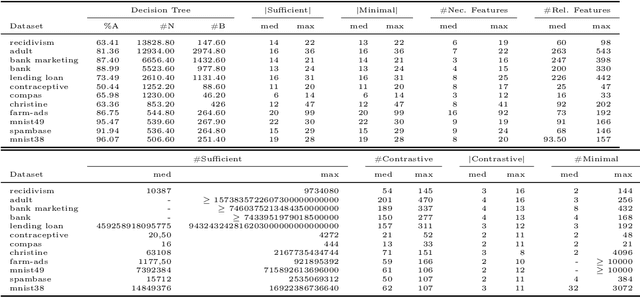
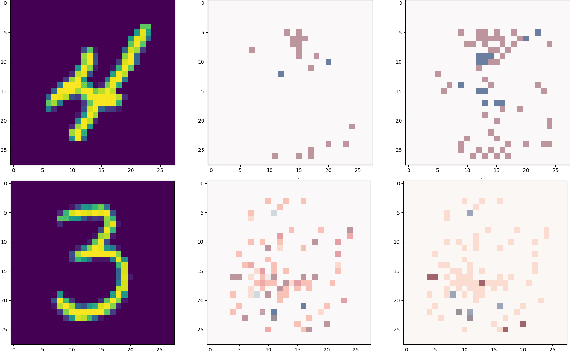
Abstract:Decision trees have long been recognized as models of choice in sensitive applications where interpretability is of paramount importance. In this paper, we examine the computational ability of Boolean decision trees in deriving, minimizing, and counting sufficient reasons and contrastive explanations. We prove that the set of all sufficient reasons of minimal size for an instance given a decision tree can be exponentially larger than the size of the input (the instance and the decision tree). Therefore, generating the full set of sufficient reasons can be out of reach. In addition, computing a single sufficient reason does not prove enough in general; indeed, two sufficient reasons for the same instance may differ on many features. To deal with this issue and generate synthetic views of the set of all sufficient reasons, we introduce the notions of relevant features and of necessary features that characterize the (possibly negated) features appearing in at least one or in every sufficient reason, and we show that they can be computed in polynomial time. We also introduce the notion of explanatory importance, that indicates how frequent each (possibly negated) feature is in the set of all sufficient reasons. We show how the explanatory importance of a feature and the number of sufficient reasons can be obtained via a model counting operation, which turns out to be practical in many cases. We also explain how to enumerate sufficient reasons of minimal size. We finally show that, unlike sufficient reasons, the set of all contrastive explanations for an instance given a decision tree can be derived, minimized and counted in polynomial time.
On Quantifying Literals in Boolean Logic and Its Applications to Explainable AI
Aug 23, 2021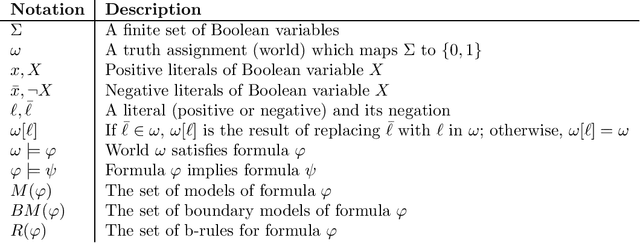
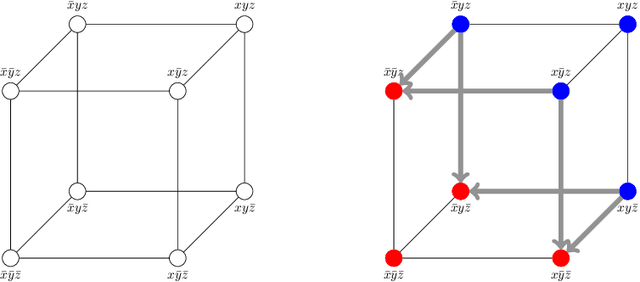


Abstract:Quantified Boolean logic results from adding operators to Boolean logic for existentially and universally quantifying variables. This extends the reach of Boolean logic by enabling a variety of applications that have been explored over the decades. The existential quantification of literals (variable states) and its applications have also been studied in the literature. In this paper, we complement this by studying universal literal quantification and its applications, particularly to explainable AI. We also provide a novel semantics for quantification, discuss the interplay between variable/literal and existential/universal quantification. We further identify some classes of Boolean formulas and circuits on which quantification can be done efficiently. Literal quantification is more fine-grained than variable quantification as the latter can be defined in terms of the former. This leads to a refinement of quantified Boolean logic with literal quantification as its primitive.
Trading Complexity for Sparsity in Random Forest Explanations
Aug 11, 2021
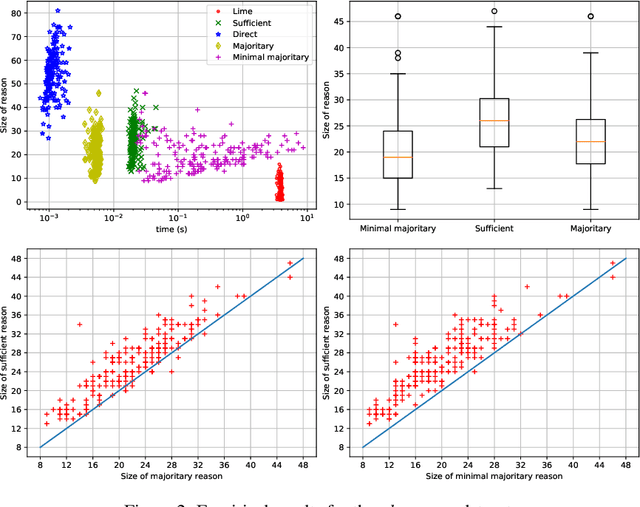
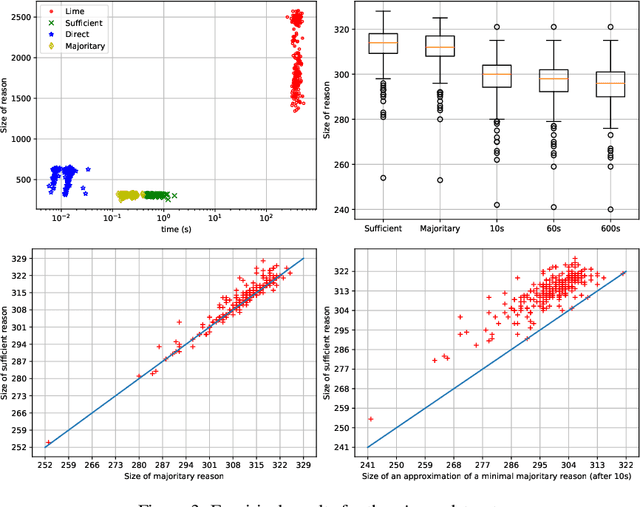
Abstract:Random forests have long been considered as powerful model ensembles in machine learning. By training multiple decision trees, whose diversity is fostered through data and feature subsampling, the resulting random forest can lead to more stable and reliable predictions than a single decision tree. This however comes at the cost of decreased interpretability: while decision trees are often easily interpretable, the predictions made by random forests are much more difficult to understand, as they involve a majority vote over hundreds of decision trees. In this paper, we examine different types of reasons that explain "why" an input instance is classified as positive or negative by a Boolean random forest. Notably, as an alternative to sufficient reasons taking the form of prime implicants of the random forest, we introduce majoritary reasons which are prime implicants of a strict majority of decision trees. For these different abductive explanations, the tractability of the generation problem (finding one reason) and the minimization problem (finding one shortest reason) are investigated. Experiments conducted on various datasets reveal the existence of a trade-off between runtime complexity and sparsity. Sufficient reasons - for which the identification problem is DP-complete - are slightly larger than majoritary reasons that can be generated using a simple linear- time greedy algorithm, and significantly larger than minimal majoritary reasons that can be approached using an anytime P ARTIAL M AX SAT algorithm.
 Add to Chrome
Add to Chrome Add to Firefox
Add to Firefox Add to Edge
Add to Edge